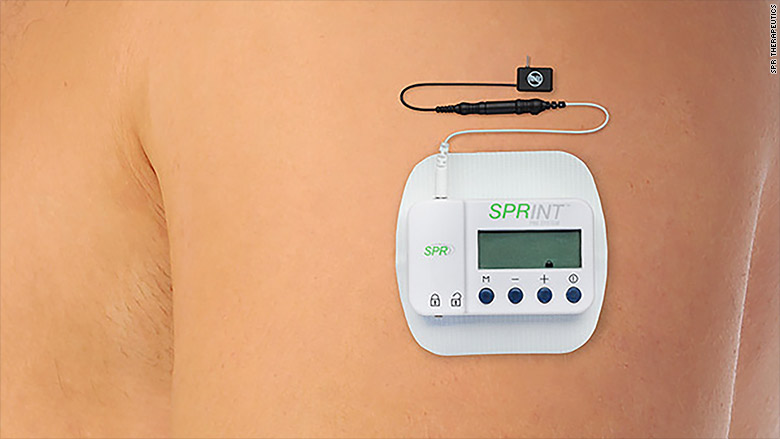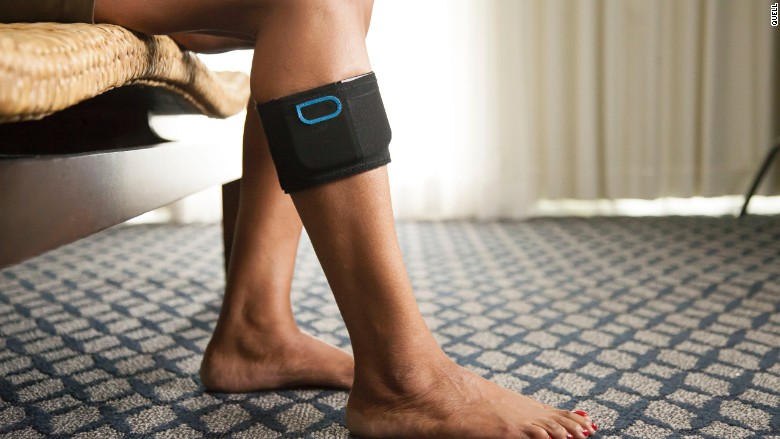
David Nipple was riding his motorcycle on a highway in Tennessee when he was hit by a drunk driver. His left leg was severed above his knee.
Medical workers didn't expect him to survive. He was bleeding quickly and had to be airlifted to nearby Nashville for treatment.
That was in 2014. Since the accident, Nipple has gone to rehabilitation and had multiple surgeries on his arm and leg.
He was prescribed narcotics, but he didn't want to take them.
"I don't care to take that stuff. I've seen what [opioid addiction] has done to too many people ... and other amputees, too" Nipple told CNN Tech.
The U.S. is in the midst of an opioid epidemic -- more than 90 people die from opioid overdoses each day, according to the Centers for Disease Control and Prevention. These deaths include those from prescription drugs, such as oxycodone, as well as illegal drugs like heroin.
Opioids are drugs that change the way your brain perceives pain. They can be addictive and people taking them often develop a tolerance, so they need higher doses for the same effect as time goes on.
Related: The opioid crisis is draining America of workers
As an opioid alternative, Nipple found a clinical trial through Facebook to test a wearable device called the Sprint PNS System from startup SPR Therapeutics.
The device uses small electrical pulses to stimulate nerves, providing patients targeted pain relief without drugs, surgery, anesthesia or a permanent implant. Nipple was among a small group of people who wore the device for about 8 weeks in 2015.

The wearable stimulator, which is about the size of an Apple Watch, is attached to the skin via a patch. It connects to a thread-like wire, which delivers the electrical pulses. It's inserted by a physician near the nerves causing pain.
The wire is removed at the end of the 30-day treatment period. The company is in the process of commercializing the device, which received FDA clearance last year.
Nipple, who said his pain was on average an eight or a nine (on a scale of one to 10), noticed relief soon after after using the device. His pain levels dropped to about a one or a two.
More than two years after the trial, he's more mobile and sleeping better. He's even ridden his 3-wheel Spyder bike from North Carolina to Wisconsin.

Study participants experienced similar results: The company found 72% of patients treated with the Sprint system had a 50% or more reduction in pain intensity or pain interference. About 78% of users still had "clinically significant" pain relief 12 months after receiving the treatment.
However, because the device is new, there aren't other studies on its effectiveness besides the company's own data.
Related: Shareholders reject CEO's pay package amid concerns over opioid epidemic
Nipple's interest in an opioid alternative is a part of a growing trend. A new study, conducted in part by SPR, released on Thursday found 92% of respondents would look for surgeons who offered effective pain management options that did not include opioids.
Patients are "absolutely" more cautious about taking opioids now, according to Stephen Leffler, chief medical officer at the University of Vermont Medical Center.
"I frequently see [patients] who say 'I don't want opiates for this,'" Leffler said. "People are definitely acutely aware of the risk of opiates and opiate addiction."
Although devices that use electrical stimulation to alleviate pain aren't new, there are more options on the market now.
Beyond Sprint, there are simple devices like a Tens unit, which can be purchased at a pharmacy for around $50. Other small devices require a permanent implant to stimulate the spinal cord.
The devices work by stimulating nerves electrically at a high enough frequency for a certain period of time, creating what feels like a vibration.
"You trigger the pain centers in the brain to produce your own pain modulators called endogenous opioids," said Shai Gozani, the founder and CEO of NeuroMetrix, which makes a tech wearable for chronic pain called Quell. "They're opioids but natural opioids."
This essentially tricks the body into overproducing these natural opioids, interfering with pain signals reaching the brain.
Related: Ohio blames drugmakers for fueling opioid crisis
NeuroMetrix's Quell wearable also works on this general principal. The device -- which was cleared by the FDA for chronic pain three years ago -- looks like a knee brace and has Bluetooth capabilities. It works with an accompanying app that can track sleep and various other health metrics.

"I should point out that it does not work for everybody," Gozani said. "You don't know who's going to benefit."
About 81% of patients in Quell's clinical study saw a general improvement in their chronic pain. But similar to SPR's trial, there's little information about the device's effectiveness beyond the company's own data.
That is a concern among experts.
"There is a need for independent research on any medical treatment. This helps everyone in the field understand the true efficacy," said Andrew Huhn, a postdoctoral fellow in the behavioral pharmacology research unit of Johns Hopkins University School of Medicine.
There also haven't been studies about which type of pain these devices are most useful for.
Some users have complained that these wearables can cause skin irritations from the band, but otherwise, no adverse side effects have been reported thus far.
Anna Lembke, a Stanford associate professor and chief of the Stanford Addiction Medicine Dual Diagnosis Clinic, said the technology is a promising alternative for patients to consider because the method is less risky than drugs.
"Anything we can promote that's shown to be effective -- that doesn't involve ingesting an opioid -- is a good thing," Lembke said.

